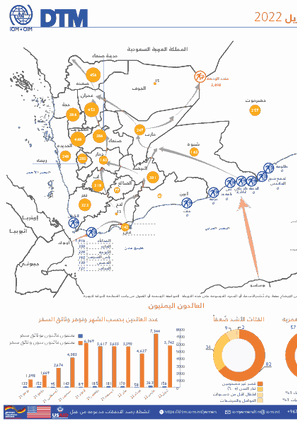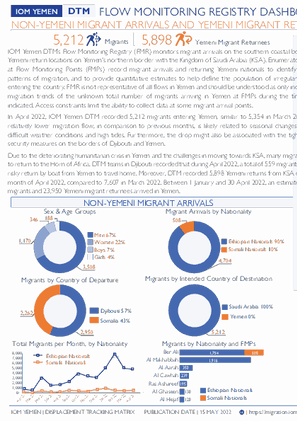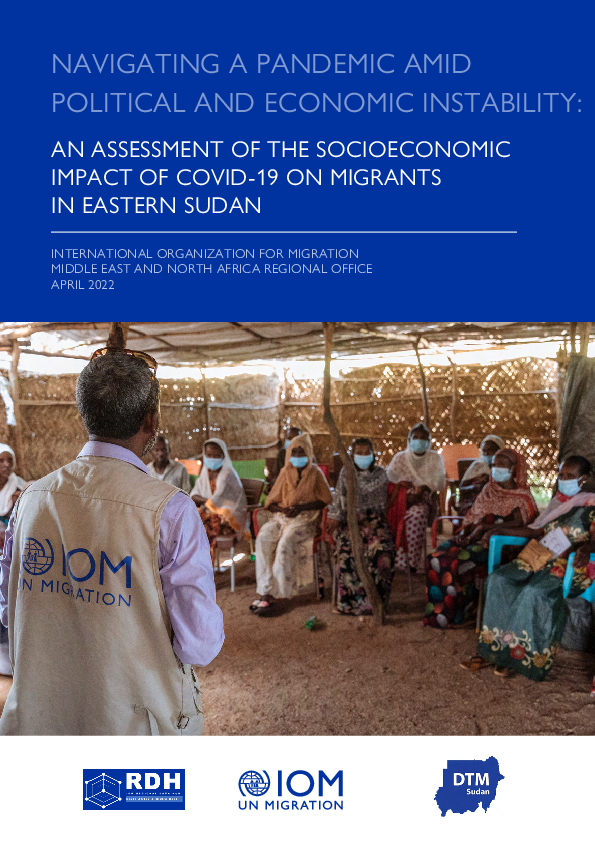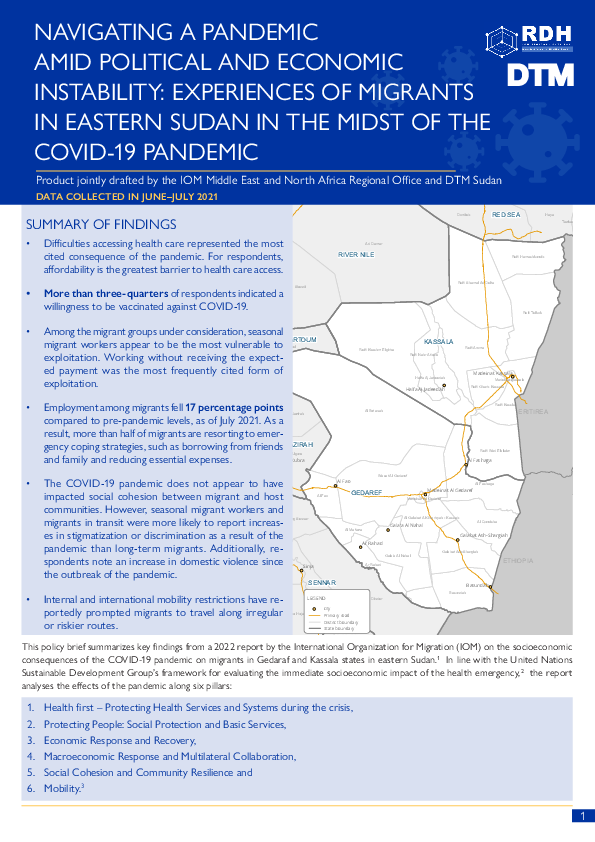-
Countries
-
Data and Analysis
-
Special Focus
-
Crisis Responses

Contact
DTM South Sudan, SouthSudanDTM@iom.int
Language
English
Location
South Sudan
Period Covered
Apr 01 2022
Apr 30 2022
Activity
- Registration
- Flow Monitoring
- Mobility Tracking
- Site Assessment
Recognizing that there have been significant population changes since the last overall biometric registration / verification, IOM DTM conducts regular population counts to monitor population dynamics and displacement trends. This exercise shows that the actual number of persons currently living at Bentiu IDP Camp remains lower than the registered total.
As per April 2022 population count findings, the Bentiu IDP Camp population stands at 112,329 individuals (17,714 households) in 12,017 inhabited shelters (on average 9 individuals per shelter). This represents a four per cent increase (4,939 individuals/834 households) compared to January 2022.

Contact
DTM Sudan; dtmsudan@iom.int
Language
English
Location
Sudan
Snapshot Date
May 11 2022
Activity
- Mobility Tracking
- Event Tracking
The DTM Emergency Event Tracking (EET) is deployed to track sudden displacement and population movements, provide more frequent updates on the scale of displacement, and quantify the affected population when needed. As a subcomponent of the new Mobility Tracking methodology in Sudan (Round Three), and activated on a need basis, EET utilises a broad network of key informants to capture best estimates of the affected population presence per location – a useful tool for humanitarian response planning and design.
Contact
DTM Yemen, iomyemendtm@iom.int
Location
Yemen
Activity
- Flow Monitoring Survey
- Flow Monitoring
- Mobility Tracking
Period Covered
Apr 01 2022 -Apr 30 2022
In April 2022, IOM Yemen DTM recorded 5,212 migrants entering Yemen, similar to 5,354 in March 2022. Thie relatively lower migration flow, in comparison to previous months, is likely related to seasonal changes including difficult weather conditions and high tides. Furthermore, the drop might also be associated with the tightening of security measures on the borders of Djibouti and Yemen.
Due to the deteriorating humanitarian crisis in Yemen and the challenges in moving towards KSA, many migrants opted to return to the Horn of Africa. DTM teams in Djibouti recorded that during April 2022, a total of 559 migrants took the risky return by boat from Yemen to travel home. Moreover, DTM recorded 5,898 Yemeni returns from KSA during the month of April 2022, compared to 7,607 in March 2022.
Between 1 January and 30 April 2022, an estimated 24,864 migrants and 23,950 Yemeni migrant returnees arrived in Yemen.
The migrant caseload was around 90 per cent Ethiopian nationals, and around 10 per cent Somali nationals. The migrants are predominantly male (67%), with (22%) women, seven per cent boys and four per cent girls also among the travelers.
Through april’s reporting period, 2,262 migrants arrived from Somalia and were recorded at Ber Ali flow monitoring point in Shabwah governorate. In Lahj governorate, 2,950 migrants arrived from Djibouti, wherein 1,916 were recorded at Al Makhabah flow monitoring point (FMP), 350 at Al Aarah FMP, 239 at Al Cowhah FMP, 195 at Ras Ashareef FMP, 130 at Al Ghaseen FMP, and 121 at Al Hejaf FMP.
Population Groups
Survey Methodology
Unit of Analysis Or Observation
Type of Survey or Assessment
Keywords
Geographical Scope
Administrative boundaries with available data
The current dataset covers the following administrative boundaries

Contact
DTM Yemen, iomyemendtm@iom.int
Language
Arabic
Location
Yemen
Period Covered
Apr 01 2022
Apr 30 2022
Activity
- Flow Monitoring Survey
- Flow Monitoring
- Mobility Tracking
في أبريل 2022 ، سجلت مصفوفة تتبع النزوح التابعة للمنظمة الدولية للهجرة في اليمن 5,212 مهاجرًا دخلوا اليمن ، مقارنة بـ 5,354 مهاجرًا في مارس 2022. من المرجح ان الانخفاض النسبي في عدد المهاجرين الواصلين مقارنة بالشهور السابقة يعود الى تغيرات احوال الطقس والمد والجزر بالاضافة الى زيادة الإجراءات الأمنية على سواحل اليمن وجيبوتي.
بسبب الأزمة الإنسانية المتدهورة في اليمن والتحديات في المضي قدمًا نحو المملكة العربية السعودية ، اختار العديد من المهاجرين العودة إلى القرن الأفريقي. حيث سجلت فرق مصفوفة تتبع النزوح في جيبوتي خلال ابريل 2022 ، خوض 599 مهاجراً رحلة العودة الخطرة على متن قوارب من اليمن. بالإضافة إلى ذلك ، سجلت مصفوفة تتبع النزوح في اليمن حوالي 5,898 يمني عادوا من المملكة العربية السعودية خلال شهر ابريل، مقارنة بـ 7,607 في مارس 2022. خلال الفترة بين 1 يناير و 30 ابريل 2022، وصل ما يقدر بـ 24,6864مهاجرًا و 23,950 يمنيًا عائداً إلى اليمن.
حيث مثل عدد المهاجرين من إثيوبيا 90 % في المائة و 10 في المائة من الصوماليين. كانت غالبية المهاجرين من الذكور (67%) مع (22%) من النساء ، و سبعة في المائة من الأولاد واربعة في المائة من الفتيات اللواتي كنا ايضاً من ضمن المسافرين.
خلال فترة التقرير في ابريل 2022، شوهد وصول 2,262 مهاجرا من الصومال وتم تسجيلهم في نقطة مراقبة التدفق في بئر علي في محافظة شبوة. بينما شهدت نقاط مراقبة التدفق بمديرية المضاربة والعارة بمحافظة لحج وصول عدد 2,950 مهاجرا وصلوا من جيبوتي , حيث تم تسجيل 1,916 في المخاباه ؛ وا 350 في العاره ؛وا 239 في الكوحة ؛وا 195 في راس الشريف ؛ وا 130 في الغصين ؛ وا 121 في الحجاف.

Contact
DTM Yemen, iomyemendtm@iom.int
Language
English
Location
Yemen
Period Covered
Apr 01 2022
Apr 30 2022
Activity
- Flow Monitoring Survey
- Flow Monitoring
- Mobility Tracking
In April 2022, IOM Yemen DTM recorded 5,212 migrants entering Yemen, similar to 5,354 in March 2022. Thie relatively lower migration flow in comparison to previous months is likely related to seasonal changes including difficult weather conditions and high tides. Furthermore, the drop might also be associated with the tightening of security measures on the borders of Djibouti and Yemen.
Due to the deteriorating humanitarian crisis in Yemen and the challenges in moving towards KSA, many migrants opted to return to the Horn of Africa. DTM teams in Djibouti recorded that during April 2022, a total of 559 migrants took the risky return by boat from Yemen to travel home. Moreover, DTM recorded 5,898 Yemeni returns from KSA during the month of April 2022, compared to 7,607 in March 2022. Between 1 January and 30 April 2022, an estimated 24,864 migrants and 23,950 Yemeni migrant returnees arrived in Yemen.
The migrant caseload was around 90 per cent Ethiopian nationals, and around 10 per cent Somali nationals. The migrants are predominantly male (67%), with (22%) women, seven per cent boys and four per cent girls also among the travelers.
Through april’s reporting period, 2,262 migrants arrived from Somalia and were recorded at Ber Ali flow monitoring point in Shabwah governorate. In Lahj governorate, 2,950 migrants arrived from Djibouti, wherein 1,916 were recorded at Al Makhabah flow monitoring point (FMP), 350 at Al Aarah FMP, 239 at Al Cowhah FMP, 195 at Ras Ashareef FMP, 130 at Al Ghaseen FMP, and 121 at Al Hejaf FMP.

Contact
DTM Sudan; dtmsudan@iom.int
Language
English
Location
Sudan
Period Covered
Jul 01 2021
Jul 31 2021
Activity
- Other
- Survey
- Community Perception
The coronavirus disease 2019 (COVID-19) pandemic and associated containment measures have impacted numerous dimensions of the lives of migrants, including their health, education, livelihoods and economic security, social cohesion and mobility. As part of the International Organization for Migration’s (IOM) efforts to draw attention to the adverse consequences of the pandemic for migrants in the Middle East and North Africa (MENA) region, this study focuses on international migrants (mainly from Ethiopia and Eritrea) living in Kassala and Gedaref states in Sudan. To differentiate between various forms of mobility between countries of origin and Sudan, this report disaggregates the impact of the pandemic across three categories of migrants:
- Long-term migrants in Sudan;
- Migrants in transit who seek to settle in a third country other than Sudan; and
- Seasonal migrant workers¦ whose stay in Sudan is temporary and who migrate between Sudan and their country of origin regularly.
The study primarily examines the socioeconomic outcomes of migrants living in Kassala and Gedaref states, regardless of their reason for coming to Sudan. The research team conducted qualitative interviews with 30 key informants and collected quantitative information from 937 respondents using a household survey. The questions posed to key informants and migrants considered the multidimensional consequences of the COVID-19 pandemic along six pillars, as adapted from the United Nations’ Sustainable Development Group’s (UNSDG) framework for evaluating the immediate socioeconomic impact of the health emergency:
- Health;
- Protection and access to basic services;
- Economic response and recovery;
- Macroeconomic response and multilateral collaboration;
- Social cohesion and community resilience;
- Mobility (2020).

Contact
DTM Sudan, DTMSudan@iom.int
Language
English
Location
Sudan
Period Covered
Jun 01 2021
Jul 15 2022
Activity
- Other
- Community Perception
This policy brief summarizes key findings from a 2022 report by the International Organization for Migration (IOM) on the socioeconomic consequences of the COVID-19 pandemic on migrants in Gedaraf and Kassala states in eastern Sudan. In line with the United Nations Sustainable Development Group’s framework for evaluating the immediate socioeconomic impact of the health emergency, the report analyses the effects of the pandemic along six pillars:
1. Health first - Protecting Health Services and Systems during the crisis,
2. Protecting People: Social Protection and Basic Services,
3. Economic Response and Recovery,
4. Macroeconomic Response and Multilateral Collaboration,
5. Social Cohesion and Community Resilience and
6. Mobility.
Contact
DTM Yemen, iomyemendtm@iom.int
Location
Yemen
Activity
- Mobility Tracking
- Event Tracking
Period Covered
May 08 2022 -May 14 2022
From 1 January to 14 May 2022, IOM Yemen DTM tracked 5,783 households (HH) (34,698 Individuals) who experienced displacement at least once.
Between 8 and 14 May 2022, IOM Yemen DTM tracked 102 households (612 individuals) displaced at least once. The majority of people moved into/within the following governorates and districts:
Between 8 and 14 May 2022, IOM Yemen DTM tracked 102 households (612 individuals) displaced at least once. The majority of people moved into/within the following governorates and districts:
- Marib (36 HHs) – Marib City (27 HHs), Marib (9 HHs) districts. Most displacements in the governorate originated from Marib and Al Hodeidah.
- Ad Dali (26 HHs) – Qatabah (14 HHs), Ad Dali (12 HHs) districts.Most displacements in the governorate originated from Ad Dali and Ibb.
- Al Hodeidah (24 HHs) – Hays (18 HHs), Al Khukhah (3 HHs), At Tuhayta (3 HHs) districts. Most displacements in the governorate originated from Taiz and Al Hodeidah.
- Al Hodeidah (29 HHs) – At Tuhayta (7 HHs), Al Khukhah (5 HHs), Al Jarrahi (5 HHs) districts.
- Marib (23 HHs) – Al Jubah (13 HHs), Madghal Al Jidan (6 HHs), Rahabah (2 HHs) districts.
- Taiz (21 HHs) – Maqbanah (15 HHs), Hayfan (2 HHs), Sharab As Salam (1 HHs) districts.
Population Groups
Survey Methodology
Unit of Analysis Or Observation
Type of Survey or Assessment
Keywords
Geographical Scope
Administrative boundaries with available data
The current dataset covers the following administrative boundaries

Contact
DTMcovid19@iom.int
Language
English
Location
Global
Period Covered
May 02 2022
May 09 2022
Activity
- Other
The DTM Global Mobility Restrictions Overview provides updates on international air travel restrictions and conditions for authorized entry. This overview aims to understand how COVID-19 has impacted human mobility, detailing how global and regional trends in air travel measures have evolved since COVID-19 was declared a global pandemic in March 2020. The data presented focuses on the changes in public health-related immigration and border management measures. It provides information intended to support IOM missions and partners in targeted response planning and advocacy for vulnerable populations who may be affected by changes in global mobility.

Contact
DTM Nigeria, AllUsersInDTMNigeria@iom.int
Language
English
Location
Nigeria
Period Covered
May 02 2022
May 08 2022
Activity
- Mobility Tracking
- Event Tracking
The DTM Emergency Tracking Tool (ETT) is deployed to track and to collect information on large and sudden population movements, provide frequent updates on the scale of displacement and quantify the affected population when needed. As a sub-component of the Mobility Tracking methodology in Nigeria. ETT utilises direct observation and a broad network of key informants to capture best estimates of the affected population per location, enabling targeted humanitarian response planning.
Between 02 and 08 May 2022, a total of 1,468 movements were recorded in Adamawa and Borno States. The recorded movements consisted of 1,171 arrivals and 297 departures. Arrivals were recorded at locations in Askira/Uba, Bama, Damboa, Gwoza, Hawul, Kala/Balge, Monguno and Ngala Local Government Areas (LGAs) of the most conflict-affected state of Borno and in Fufore, Girei, Gombi, Hong, Lamurde, Michika, Song, Yola North and Yola South LGAs of Adamawa State.
Departures were recorded in Gwoza and Kala/Balge LGAs of Borno State and in Fufore, Hong, Maiha, Yola North and Yola South LGAs of Adamawa State.
ETT assessments identified the following movement triggers: family reunification (670 individuals or 46%), military operations (242 individuals or 17%), conflicts/attacks (196 individuals or 13%), seasonal farming (124 individuals or 8%), poor living conditions (82 individuals or 6%), search for better living conditions (76 individuals or 5%), improved security (63 individuals or 4%) and fear of attacks (15 individuals or 1%).